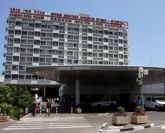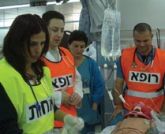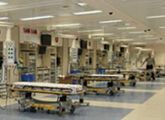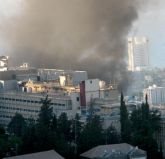×


We have detected your country as:
Please click here to go to the USA website or select another country from the dropdown list.
 Chris Parypa/Shutterstock.com Since its emergence as a nation in 1948, Israel has had to live in a state of perpetual high alert. With enemies threatening on her every border, this tiny nation realizes she has no choice but to maintain constant vigilance.
Chris Parypa/Shutterstock.com Since its emergence as a nation in 1948, Israel has had to live in a state of perpetual high alert. With enemies threatening on her every border, this tiny nation realizes she has no choice but to maintain constant vigilance.
There are a multitude of ways Israel is preparing for future conflict—this article focuses on two special defensive strategies in Israel’s arsenal: a new system to protect Israeli commercial aircraft from shoulder-launched surface-to-air missiles, and a unique, fortified underground hospital in Israel’s north. Both measures highlight Israel’s extraordinary technological expertise in the area of defense.
 El AL jets will be
El AL jets will be
protected by laser system
Chris Parypa/Shutterstock.com The threat of surface-to-air missiles to vulnerable commercial aircraft has long been a concern for the world’s airlines. It takes a mere 6–10 seconds for a missile to reach its target from the ground, leaving pilots with no time to take evasive action.
In 2002, terrorists fired two surface-to-air missiles at an Israeli plane on take-off in Mombasa, Kenya, putting 250 people in peril. The missiles missed their target, but the episode prompted Israel to investigate new defense strategies to respond to the threat. Surface-to-air missiles are proliferating at an alarming rate worldwide. China and Iran are instrumental in much of their distribution to terrorist organizations.
For a number of years, all Israeli military aircraft have been equipped with an infrared system to combat missiles. At the end of March, Israel’s Ministry of Defense announced that SkyShield, the Israeli-made laser-defense system, was ready for commercial use after rigorous testing. EL AL aircraft will be the first to have the anti-missile devices installed, but the developer, Elbit Systems, has contracts with other nations as well.
The fully automated system detects, through an infrared sensor, any missile that has been launched towards the aircraft, and fires a laser beam to confuse the missile’s navigation system, veering it from its flight path and exploding it at a safe distance from the plane. The Israeli system is regarded as the most advanced in the world, acclaimed for its reliability and ability to deal with multiple threats simultaneously.
 Rambam Hospital
Rambam Hospital
Rambam archives During the Second Lebanon War in 2006, Israel’s north was bombarded by rockets from Hizbullah. Rambam Health Care Campus in Haifa was inundated with civilian and military casualties. Helicopters were arriving from the northern front loaded with the severely wounded; rockets were falling within a half-mile radius of the hospital, and the walls were shaking with the force of the explosions. Patients were moved to the old bomb shelter in the basement, but a direct hit would have been catastrophic.
Rambam came to the staggering conclusion that their hospital was, by no means, a safe place during war or disaster, and that they needed to function more effectively under those extreme conditions. Professor Karl Skorecki, Director of Medical and Research Development at Rambam stated, “This was not something we took into account: the fact that the hospital itself could be vulnerable. We were saving lives on the one hand, but at the same time, we were vulnerable to the loss of life because of deadly missile attacks.”
 Trauma staff practicing
Trauma staff practicing
Rambam archives A decision was made then to build a state-of-the-art fortified, underground medical facility that would revolutionize the way Israel protected some of her most vulnerable—sick and elderly patients, those stricken by cancer, and pregnant women—confined to their beds and unable to protect themselves.
The Sammy Ofer Fortified Underground Emergency Hospital was conceived and designed; and, in October 2010, construction began—the largest medical facility of its kind in the world.
The concept for the hospital was adapted from a Singapore model where an underground facility was in place on a much smaller scale. But the concept on a scale of the magnitude of Rambam doesn’t exist anywhere else in the world.
In peacetime, the facility functions as a 3-level underground parking lot. In a time of war, it is designed to protect its patients and staff from conventional, chemical and biological attacks. The sides and top of the facility are reinforced by multiple layers of concrete, completely protected from whatever is happening outside its walls, even seismic tremors and other natural disasters.
 Underground facility
Underground facility
Rambam archives In March, the first emergency preparedness drill in the new facility took place. Within 72 hours, the 1,500-car parking garage was converted into a 2,000-bed emergency underground hospital. Patients and medical equipment were transferred from the main hospital to the underground facility. High-tech systems allow the hospital to be completely sealed off and self-sufficient, able to generate its own power, air filtration, oxygen, medical gas, and drinking water, for up to 72 hours. Emergency rooms, operating rooms and an intensive care unit will be fully operational, with ventilators, monitors, pumps, dialysis equipment, computers and all other necessary medical equipment.
 Haifa hospitals under
Haifa hospitals under
rocket attack in 2006
Flickr/tomer.gabel/www.wikipedia.org Wartime experience has made Rambam hospital the go-to trauma treatment center and a world leader in mass trauma and casualty education. Israel is sharing her expertise with medical personnel around the world, and in turn, international doctors have pledged to be on stand-by to help Israel in times of national crisis. Providing acute and chronic hospital care under fire will be a necessity in any future conflict, and now, with the completion of this new fortified underground emergency hospital, Israel is prepared for any crisis.
Source: By Kathy DeGagné, BFP Staff Writer
All logos and trademarks in this site are property of their respective owner. All other materials are property of Bridges for Peace. Copyright © 2025.
Website Site Design by J-Town Internet Services Ltd. - Based in Jerusalem and Serving the World.